Vpsh ransomware (Free Instructions) - Decryption Steps Included
Vpsh virus Removal Guide
What is Vpsh ransomware?
Vpsh ransomware is a type of malware that encrypts personal files and demands money
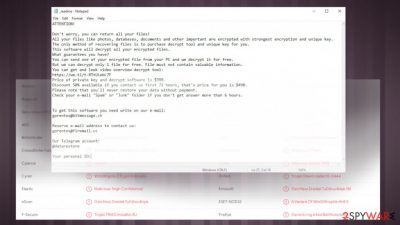
Vpsh ransomware – a computer infection that encrypts[1] all personal files with a .vpsh extension, restricting access to them. Malware then drops a ransom note _readme.txt, which claims that the only way to securely return data is by paying a ransom of $980/$490 – it should be delivered using bitcoin digital currency. In the note, threat actors provide contact emails – helpmanager@mail.ch and restoremanager@airmail.cc.
Vpsh virus derives from a well-known Djvu family, which consists of over 250 variants, including Mmpa, Foqe, or Moss ransomware. In this article, we will provide alternative methods for .vpsh file recovery and safe ways of deleting the infection from your device.
| Name | Vpsh ransomware |
|---|---|
| Type | Ransomware, crypto-virus, file locking virus |
| Malware family | Djvu/STOP virus family |
| Extension | Files get .vpsh extension, for example, “one.jpg” is turned into “picture.jpg.vpsh” |
| Ransom note | _readme.txt file stores the message from virus creators and not only explains what happened to your system but also demands to pay the ransom |
| Contact | helpmanager@mail.ch, restoremanager@firemail.cc |
| File recovery | If you don't have backups, recovering data is almost impossible. Nonetheless, we suggest you try alternative methods that could help you in some cases. We listed them above. Also, try the decryption tool and check if Ids used for your computer are offline, or try to restore media files with the repair application |
| Distribution | Ransomware can infiltrate the system through infected email attachments, malicious ads, or if you install suspicious software from torrent sites or other questionable sources |
| Malware removal | You need to scan the system with powerful anti-malware software and remove Vpsh ransomware |
| System fix | Malware can cause errors, crashes, lag, and other stability issues. We recommend scanning the system with the FortectIntego repair tool that can indicate and even fix some virus damage for you |
After the successful encryption process, the Vpsh ransomware drops a ransom note. Cybercriminals try to demand money from its victim by saying that the only possible solution to recover files is to pay them. According to them, the initial ransom fee is $980, but if the victim will choose to get in touch with hackers within three days of the attack, they get a 50% discount.
Developers of Vpsh ransomware provide two different email addresses to contact them. But according to cybersecurity experts,[2], it is not recommended to speak with hackers. Also, cybercriminals even give the URL to a video about the decryption tool. The full ransom note in the _readme.txt file looks as follows:
ATTENTION!
Don't worry, you can return all your files!
All your files like pictures, databases, documents and other important are encrypted with strongest encryption and unique key.
The only method of recovering files is to purchase decrypt tool and unique key for you.
This software will decrypt all your encrypted files.
What guarantees you have?
You can send one of your encrypted file from your PC and we decrypt it for free.
But we can decrypt only 1 file for free. File must not contain valuable information.
You can get and look video overview decrypt tool:
https://we.tl/t-7WqJh5indg
Price of private key and decrypt software is $980.
Discount 50% available if you contact us first 72 hours, that's price for you is $490.
Please note that you'll never restore your data without payment.
Check your e-mail “Spam” or “Junk” folder if you don't get answer more than 6 hours.To get this software you need write on our e-mail:
helpmanager@mail.chReserve e-mail address to contact us:
restoremanager@airmail.ccYour personal ID:
Unfortunately, cybercriminals are not lying about the unique decryption key that is needed to restore .vpsh files. But you should try to recover the data with the methods explained above. We provided clear instructions on how to remove Vpsh ransomware too.
Of course, before trying any recovery method, you must remove Vpsh ransomware from the system. We recommend using SpyHunter 5Combo Cleaner or Malwarebytes – powerful tools that detect and terminate all threats on your computer. Also, viruses can damage the system, thus use a reliable repair tool to fix any issues. For example, one of the best solutions can be FortectIntego.
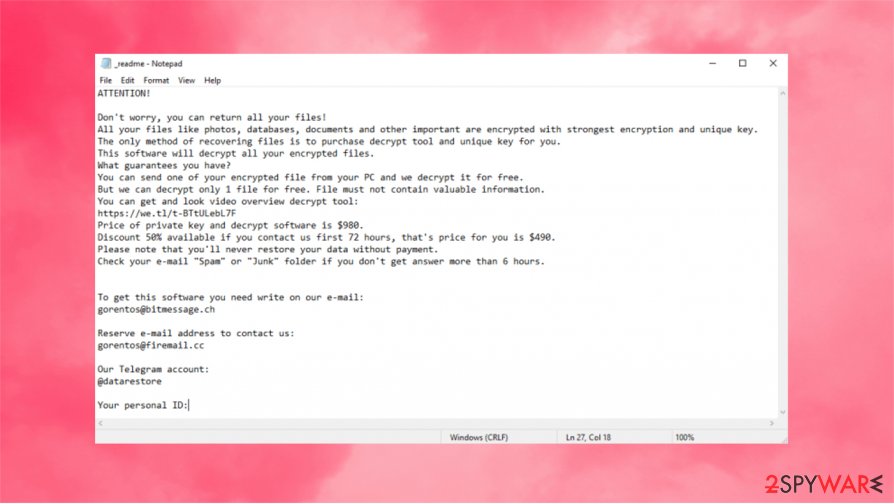
.vpsh files recovery solutions
Many people mistakenly believe that if they remove ransomware[3] then all files will be unlocked automatically. Unfortunately, these users are wrong because malware uses a secure encryption algorithm to lock data. This means that each victim gets a randomly-generated ID and key, and until Vpsh ransomware removal is complete, file recovery is dangerous. You can't decrypt files without this key, and only the attackers have access to it.
Of course, experts say that you shouldn't pay the ransom in order to recover your files. The best decision is to remove .vpsh file virus and try other methods to recover the data. If you don't have backups, the most effective method is a free decryption tool for Djvu ransomware victims.
This decryption tool provided by Emsisoft and already helped many uses. However, the decryptor works only if the offline ID was used by Vpsh ransomware, or somebody already paid the ransom and shared the offline key with Emsisoft cybersecurity researchers.
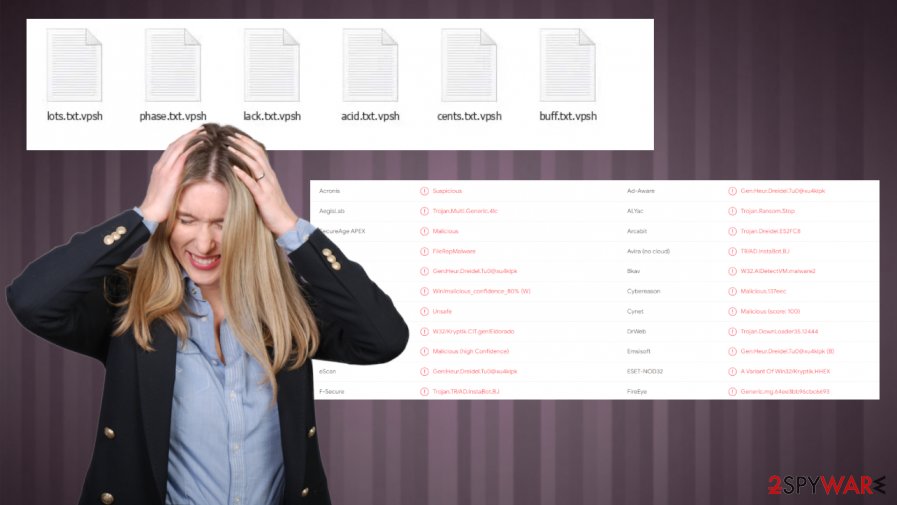
If the virus created an online ID, then decryption is not possible because each victim gets a unique key. Nonetheless, you can try to restore at least some files. We explained methods on how to restore .vpsh files at the bottom of this article. Try them all and maybe you will retrieve your pictures, videos, and other personal data.
Tips on how to remove Vpsh ransomware and restore files
Vpsh ransomware – is a cryptovirus that most likely got inside your computer when you downloaded content from torrent sites or other unsafe sources. Cybercriminals like to take advantage of unprotected websites and plant malware in free software, cracks of licensed version programs, etc. We recommend downloading data only from reliable sources in the future.
As we explained before, you should remove Vpsh ransomware from the system as soon as possible. The best way to get rid of serious threat is by using reliable anti-malware software. We recommend relying on SpyHunter 5Combo Cleaner or Malwarebytes. After that, you can try to restore the data.
Unfortunately, Vpsh ransomware removal won't help to recover files. Anti-malware programs only delete the threat, but locked files and other issues remain there. When you successfully eliminated the virus, you can recover files from backups and fix all damage with a reliable repair tool like FortectIntego.
Getting rid of Vpsh virus. Follow these steps
Manual removal using Safe Mode
You need to reboot the computer in Safe Mode with Networking if you want to remove Vpsh ransomware
Important! →
Manual removal guide might be too complicated for regular computer users. It requires advanced IT knowledge to be performed correctly (if vital system files are removed or damaged, it might result in full Windows compromise), and it also might take hours to complete. Therefore, we highly advise using the automatic method provided above instead.
Step 1. Access Safe Mode with Networking
Manual malware removal should be best performed in the Safe Mode environment.
Windows 7 / Vista / XP
- Click Start > Shutdown > Restart > OK.
- When your computer becomes active, start pressing F8 button (if that does not work, try F2, F12, Del, etc. – it all depends on your motherboard model) multiple times until you see the Advanced Boot Options window.
- Select Safe Mode with Networking from the list.

Windows 10 / Windows 8
- Right-click on Start button and select Settings.

- Scroll down to pick Update & Security.

- On the left side of the window, pick Recovery.
- Now scroll down to find Advanced Startup section.
- Click Restart now.

- Select Troubleshoot.

- Go to Advanced options.

- Select Startup Settings.

- Press Restart.
- Now press 5 or click 5) Enable Safe Mode with Networking.

Step 2. Shut down suspicious processes
Windows Task Manager is a useful tool that shows all the processes running in the background. If malware is running a process, you need to shut it down:
- Press Ctrl + Shift + Esc on your keyboard to open Windows Task Manager.
- Click on More details.

- Scroll down to Background processes section, and look for anything suspicious.
- Right-click and select Open file location.

- Go back to the process, right-click and pick End Task.

- Delete the contents of the malicious folder.
Step 3. Check program Startup
- Press Ctrl + Shift + Esc on your keyboard to open Windows Task Manager.
- Go to Startup tab.
- Right-click on the suspicious program and pick Disable.

Step 4. Delete virus files
Malware-related files can be found in various places within your computer. Here are instructions that could help you find them:
- Type in Disk Cleanup in Windows search and press Enter.

- Select the drive you want to clean (C: is your main drive by default and is likely to be the one that has malicious files in).
- Scroll through the Files to delete list and select the following:
Temporary Internet Files
Downloads
Recycle Bin
Temporary files - Pick Clean up system files.

- You can also look for other malicious files hidden in the following folders (type these entries in Windows Search and press Enter):
%AppData%
%LocalAppData%
%ProgramData%
%WinDir%
After you are finished, reboot the PC in normal mode.
Remove Vpsh using System Restore
System Restore feature can help to recover machine in a previous state
-
Step 1: Reboot your computer to Safe Mode with Command Prompt
Windows 7 / Vista / XP- Click Start → Shutdown → Restart → OK.
- When your computer becomes active, start pressing F8 multiple times until you see the Advanced Boot Options window.
-
Select Command Prompt from the list

Windows 10 / Windows 8- Press the Power button at the Windows login screen. Now press and hold Shift, which is on your keyboard, and click Restart..
- Now select Troubleshoot → Advanced options → Startup Settings and finally press Restart.
-
Once your computer becomes active, select Enable Safe Mode with Command Prompt in Startup Settings window.

-
Step 2: Restore your system files and settings
-
Once the Command Prompt window shows up, enter cd restore and click Enter.

-
Now type rstrui.exe and press Enter again..

-
When a new window shows up, click Next and select your restore point that is prior the infiltration of Vpsh. After doing that, click Next.


-
Now click Yes to start system restore.

-
Once the Command Prompt window shows up, enter cd restore and click Enter.
Bonus: Recover your data
Guide which is presented above is supposed to help you remove Vpsh from your computer. To recover your encrypted files, we recommend using a detailed guide prepared by 2-spyware.com security experts.If your files are encrypted by Vpsh, you can use several methods to restore them:
Data Recovery Pro is a good option if you want to restore files
Data Recovery Pro is a program that helps recover files.
- Download Data Recovery Pro;
- Follow the steps of Data Recovery Setup and install the program on your computer;
- Launch it and scan your computer for files encrypted by Vpsh ransomware;
- Restore them.
Use Windows Previous Versions feature
Sometimes it is possible to recover files one-by-one with Windows Previous Versions feature.
- Find an encrypted file you need to restore and right-click on it;
- Select “Properties” and go to “Previous versions” tab;
- Here, check each of available copies of the file in “Folder versions”. You should select the version you want to recover and click “Restore”.
ShadowExplorer can help you to recover data if the Vpsh file virus failed to delete Shadow Volume Copies
- Download Shadow Explorer (http://shadowexplorer.com/);
- Follow a Shadow Explorer Setup Wizard and install this application on your computer;
- Launch the program and go through the drop down menu on the top left corner to select the disk of your encrypted data. Check what folders are there;
- Right-click on the folder you want to restore and select “Export”. You can also select where you want it to be stored.
Use Emsisoft's decryption tool
If your personal files were encrypted with an offline ID, Emsisoft's Decryptor for Djvu might be able to help you.
- Download Emsisoft's decryptor for Djvu [download link].
- Click on the decrypt_STOPDjvu.exe file at the bottom-left of your browser tab.
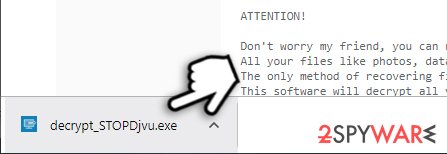
- Agree to License Terms.
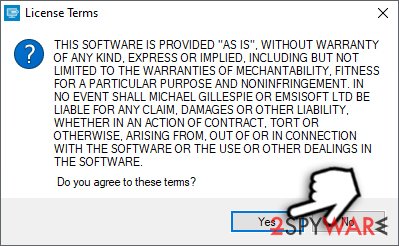
- Click OK when Disclaimer window shows up.
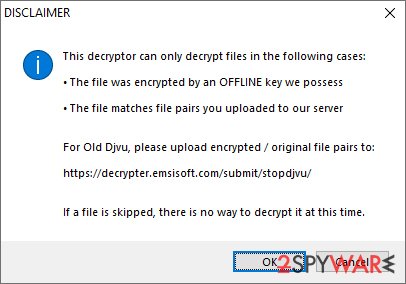
- The Decryptor should automatically populate the encrypted file folders, although you can add them manually as well by pressing Add folder.
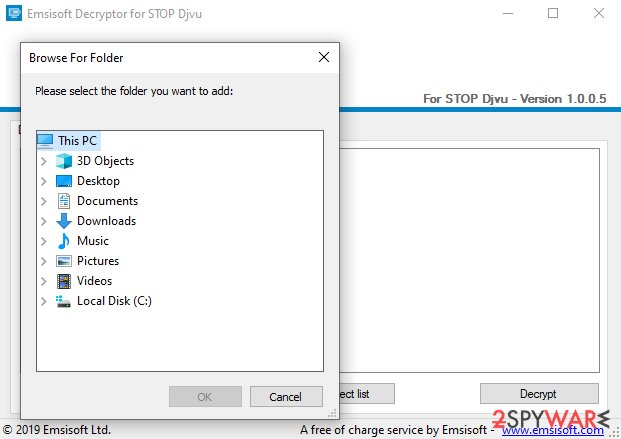
- The tool will run for sometime and report whether your files can be decrypted.
From here, there are three outcomes that are available:
- “Decrypted!” will be shown under files that were decrytped successfully – they are now usable again.
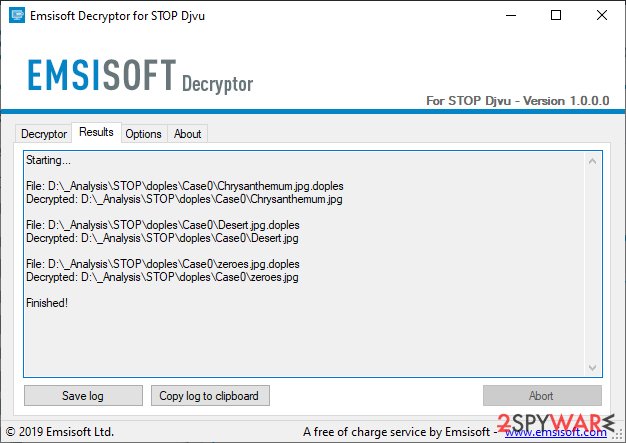
- “Error: Unable to decrypt file with ID:” – this means that the offline keys for this version of Djvu has not been recovered yet (should try later).
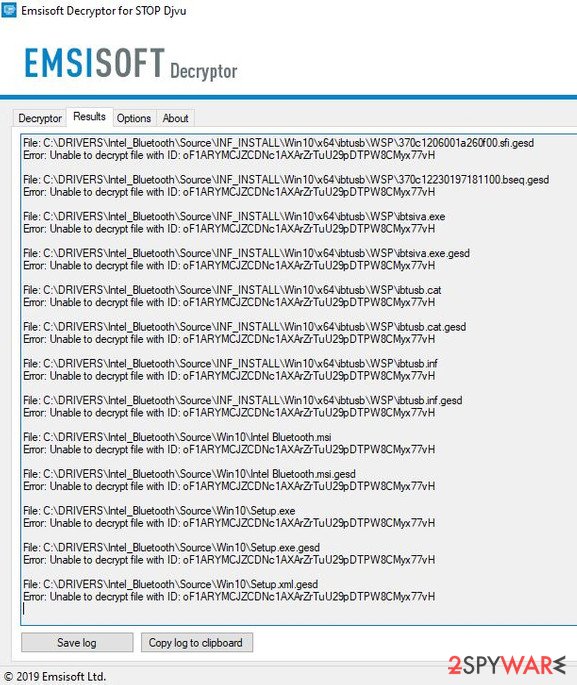
- “This ID appears to be an online ID, decryption is impossible” – as description explains, decryption is not possible with the decryptor.
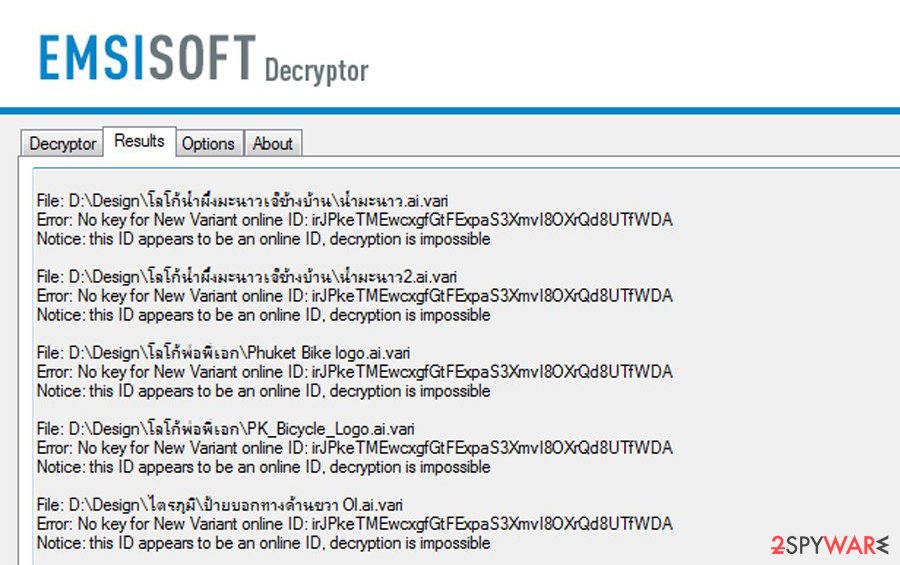
Finally, you should always think about the protection of crypto-ransomwares. In order to protect your computer from Vpsh and other ransomwares, use a reputable anti-spyware, such as FortectIntego, SpyHunter 5Combo Cleaner or Malwarebytes
How to prevent from getting ransomware
Protect your privacy – employ a VPN
There are several ways how to make your online time more private – you can access an incognito tab. However, there is no secret that even in this mode, you are tracked for advertising purposes. There is a way to add an extra layer of protection and create a completely anonymous web browsing practice with the help of Private Internet Access VPN. This software reroutes traffic through different servers, thus leaving your IP address and geolocation in disguise. Besides, it is based on a strict no-log policy, meaning that no data will be recorded, leaked, and available for both first and third parties. The combination of a secure web browser and Private Internet Access VPN will let you browse the Internet without a feeling of being spied or targeted by criminals.
No backups? No problem. Use a data recovery tool
If you wonder how data loss can occur, you should not look any further for answers – human errors, malware attacks, hardware failures, power cuts, natural disasters, or even simple negligence. In some cases, lost files are extremely important, and many straight out panic when such an unfortunate course of events happen. Due to this, you should always ensure that you prepare proper data backups on a regular basis.
If you were caught by surprise and did not have any backups to restore your files from, not everything is lost. Data Recovery Pro is one of the leading file recovery solutions you can find on the market – it is likely to restore even lost emails or data located on an external device.
- ^ Encryption. Wikipedia. The free encyclopedia.
- ^ Los Virus. Los Virus. News about security and viruses.
- ^ Danny Palmer. What is ransomware? Everything you need to know about one of the biggest menaces on the web. ZDNet. News articles.





















